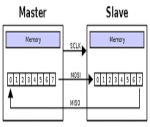There are different communication technologies existing for communication between IoT devices but Bluetooth & Wi-Fi Technology is very famous ones. These two communication technologies have some limitations like access points, limited range, high power consumption, etc. Similarly, local area networks & mobile networks also have high power consumption and are quite expensive too. IoT industries from the past few years have launched many technologies but they are not perfect. So to … [Read more...]
What is Inter-Process Communication : Working,Types & Its Applications
In modern computer systems, the concept of a process (a program in execution) is used to perform multiple tasks at the same time. And since multiple processes running on a single or multiple computers at the same time are connected to a network can exchange the data/information through a process called inter-process communication (IPC). This article gives a brief description of inter-process communication between the processes. Definition of Inter-Process Communication: Inter-process … [Read more...]
What is I3C Protocol : Working & Its Applications
At present, the usage of sensors in mobile devices has increased so it is becoming complex for manufacturers to utilize existing methods like I2C & SPI. So, the MIPI alliance members launched the first I3C protocol which is also called “Improved Inter-Integrated Circuits in the year 2017 by the MIPI Alliance called MIPI I3C v1.0. In October month 2018, the MIPI I3C Basic v1.0 was launched, and after that MIPI I3C v1.1 version was released in the month of December 2019. This is an e … [Read more...]
What is IEEE 488 Bus or GPIB : Working & Its Applications
During the 1960s, HP developed many different tests and measuring devices like logic analyzers and multimeters. In order to achieve smoother interconnection between controllers and measuring instruments, the HP-IB was introduced (HP Interface Bus). HPIB is the original name for GPIB (General Purpose Interface Bus), whereas later it got many other names. Finally, the Institute of Electrical and Electronics Engineers has provided a specification number to GPIB which is 488 in the year 1978. From … [Read more...]
What is Antenna Array : Architecture & Its Applications
The antenna is the most essential component of the radio equipment and the antennas were first developed by Heinrich Hertz in the year 1888. Later on, the antennas were developed to use for long-distance applications and wireless telegraphy. Moving on with the concept of antenna, Ferdinand Braun invented the concept of antenna array by placing three monopoles in the form of a triangle. So, let's discuss more on the need for an antenna array, antenna array definition, radiation pattern, its gain, … [Read more...]
What is Yagi Uda Antenna : Design, Working & Its Applications
Over a century ago two men independently invented the Yagi-Uda antenna. Ever heard of it? Neither had we before we started looking at the history of the invention. Invented in 1926 by Shintaro Uda of Tohoku Imperial University and Hidetsugu Yagi, Kiyoshi Kawakami, and other colleagues at the same university, it was the first antenna designed to exploit the advantage of receiving signals from multiple directions to cancel out noise or jamming with high gain, high directionality, and uninterrupted … [Read more...]
What is CAN Protocol : Architecture, Working and Types
Formerly, automobile manufacturers used to connect various electronic devices in automobiles using a number of wires through point-to-point connections. This resulted in huge wire connections which were very expensive and bulky. Later, this complicated wiring system got replaced by dedicated wiring that enhanced communication speed between devices and provided high integrity, and was named as controller area network. The CAN was first developed by Bosch in the year 1985 for in-vehicle … [Read more...]
What is Serial Peripheral Interface : Working and Its Applications
As we know that communication between humans happens in multiple languages, in a similar way communication between electronic devices happens. But both the communication devices should speak the same language. The languages that the devices speak are termed communication protocols. There exist a few communication protocols such as UART communication, I2C protocol, and SPI (Serial Peripheral Interface) protocols. Today, this article let us understand the SPI protocol definition, its block … [Read more...]
What is Time Division Multiplexing : Working & Its Applications
Multiplexing is a method used to merge & transmit multiple data streams over a particular medium. In telecommunications, the multiplexing technique are extensively used where numerous telephone calls are carried throughout a single wire. This concept originated in the early 1870s in telegraphy and then the telephone carrier multiplexing was developed in 1910 by George Owen Squier later followed by different types of multiplexing. Some of the types of multiplexing techniques available are … [Read more...]
What is I2C Protocol : Architecture, Timing Diagram & Its Applications
In the process of establishing a connection between multiple devices in a microcontroller, the data and address line of every single device would take up important pins in the microcontroller which leads to more traces on the PCB board. And also it requires more components which further results in cost enhancement of the system and they are even easily subjective to noise and intrusion. So, to stay back from this complication Philips introduced IC buses which were also called I2C in the year the … [Read more...]
- 1
- 2
- 3
- …
- 6
- Next Page »









